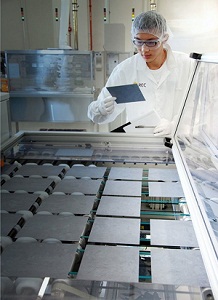REC develops silicon-based PV with one-year energy payback
 It hasn’t been talked about much lately, but one thing that has plagued the silicon photovoltaic (PV) industry is the energy-payback time. That’s the time it takes for a module to produce as much energy as was used to make it. REC (Renewable Energy Co.) has developed a new method of producing silicon for photovoltaics that uses significantly less energy to produce and reduces that critical energy-payback time to just one-year.
It hasn’t been talked about much lately, but one thing that has plagued the silicon photovoltaic (PV) industry is the energy-payback time. That’s the time it takes for a module to produce as much energy as was used to make it. REC (Renewable Energy Co.) has developed a new method of producing silicon for photovoltaics that uses significantly less energy to produce and reduces that critical energy-payback time to just one-year.
The energy payback time for other manufacturers of silicon photovoltaics can be much higher at five or more years. But REC, an integrated solar company that manufactures silicon, photovoltaics and develops projects, has developed the Fluidized Bed Reactor (FBR) process, which creates granular silicon for photovoltaics, which uses significantly less energy to produce crystalline silicon for solar cells.
The process was awarded the 2011 Solar Industry Award on Sept. 6 by Solar Industry Magazine at the EUPVSEC solar conference. The following day REC’s modules were certified as having a one-year energy payback time through a Life-Cycle Analysis conducted by the Energy Research Centre of the Netherlands.
“We produce a small, granular polysilicon,” said REC spokesperson Anne Ekern. “The production process uses approximately 10 percent of the energy of traditional Siemens silicon processing.”
Traditionally, silicon for photovoltaics is made using a high-temperature process.
“Basically, what you do is grow a rod in a big container. It becomes thicker and thicker and you harvest it,” said Ekern.
The process requires a significant amount of time and energy and is a leading cost driver for photovoltaics.
REC’s proprietary FBR process still requires the heat, but it’s a continual process that doesn’t require the cooling process that the Siemens technique does, Ekern said.
“The silicon granules can also be added to ingots when they’re processed by photovoltaic manufacturers, making their production process more efficient and less energy intensive. They can put the [FBR silicon] it in a container and melt it,” Ekern said. “If you mix big Siemens chunks with the small granular silicon, you can fill the void and make their processes more efficient.”
REC now uses a roughly 50/50 blend of FBR silicon and traditionally grown silicon in their photovoltaics, according to Ekern.
That’s the blend that is currently most cost-effective for the company. But REC could increase the amount of FBR in the future.
Image courtesy of REC.



